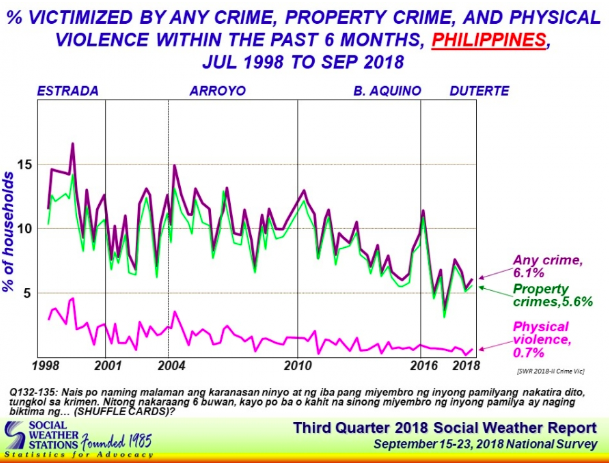The number of Filipino families who said they were victims of any common crime slightly rose, according to a September Social Weather Stations (SWS) survey, as apprehension about burglary, unsafe streets and drug addicts lingered.
Results of the SWS survey, released on Thursday night, found some 1.4 million families or 6.1 percent saying a household member was victimized by pickpocketing or robbery of personal property, break-ins, car theft or physical violence in the six months prior to the survey.
The latest victimization rate is up from 5.3 percent or 1.2 million families in June, but similar to the 6.1 percent recorded in the September last year.
Unsafe streets
Fear of neighborhood security remained, with about one in two families still worried about burglaries and unsafe streets while two in five were concerned about the presence of drug addicts in their neighborhood.
The latest survey was conducted from Sept. 15 to 23 using face-to-face interviews with 1,500 adults nationwide.
It has a margin of error of plus or minus 3 percentage points.
SWS noted that the poll figures were much higher than the number of crimes actually reported to the police.
The proportion of those who said they fell victim to property crimes, whether street robbery, break-ins or car theft, rose from 5.1 percent in June to 5.6 percent in September.
Further, SWS found that 4.6 percent said they had fallen victim to pickpockets in September, from 4 percent in June while 2 percent had been victims of break-ins at their homes, from 1.8 percent, and 0.6 percent fell victim to car theft, from 0.5 percent.
Meanwhile, 52 percent agreed that in their neighborhood, “people are usually afraid that robbers might break into their houses,” down from 55 percent in June.
Nearly half or 46 percent agreed with the statement, “In this neighborhood, people are usually afraid to walk in the street at night because it is not safe.” This figure is unchanged from June.
The proportion of families who agreed that “many people addicted to banned drugs” are in their neighborhoods was unchanged at 41 percent.—INQUIRER RESEARCH


